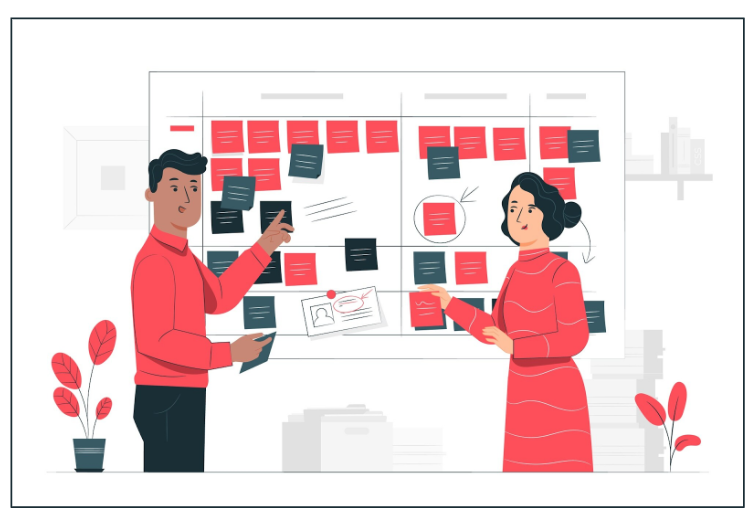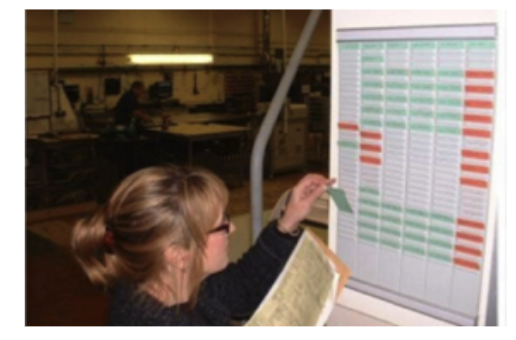 Kamishibai boards offer a straightforward way to manage tasks and processes with a visual red-green card system where the red side of the card shows the task is incomplete and the green side of the card shows that the task has been completed. They enhance accountability by providing a clear overview of task status, aiding managers in monitoring progress while “walking the floor.” As a manager walks past an area that has one of these boards then they should be able to see a wave of green cards forming. It’s very easy to see one of two things; either that the board is not being used, or that progress is being made. The system fosters a culture of honesty and integrity, discouraging manipulation attempts like people turning the cards over prematurely just to give the right impression. For example, a manufacturing company had a task related to the checking of oil at the start of every shift. The cards were turned over religiously and then the machine seized! It was very easy for the manager to work out who had been trying to fiddle the system… the system was adhered to from that point onwards! Thus, Kamishibai boards promote open communication and transparency, facilitating continuous improvement within the organization, ultimately driving efficiency and effectiveness.
Kamishibai boards offer a straightforward way to manage tasks and processes with a visual red-green card system where the red side of the card shows the task is incomplete and the green side of the card shows that the task has been completed. They enhance accountability by providing a clear overview of task status, aiding managers in monitoring progress while “walking the floor.” As a manager walks past an area that has one of these boards then they should be able to see a wave of green cards forming. It’s very easy to see one of two things; either that the board is not being used, or that progress is being made. The system fosters a culture of honesty and integrity, discouraging manipulation attempts like people turning the cards over prematurely just to give the right impression. For example, a manufacturing company had a task related to the checking of oil at the start of every shift. The cards were turned over religiously and then the machine seized! It was very easy for the manager to work out who had been trying to fiddle the system… the system was adhered to from that point onwards! Thus, Kamishibai boards promote open communication and transparency, facilitating continuous improvement within the organization, ultimately driving efficiency and effectiveness.
Creating a Kamishibai board involves several steps:
- Define the Time Period:
- Determine the cycle that best suits the needs: daily, weekly, or monthly.
- Design the board with columns representing each time period, such as:
Daily | Week 1 | Week 2 | Week 3 | End of Month
Or
Monday | Tuesday | Wednesday | Thursday | Friday
- Brainstorm Tasks:
- Make a list of tasks that occur within the selected time period.
- Consider tasks that might be overlooked or need more frequent attention.
- Create Cards:
- Use red and green “T” cards, or purchase pre-coloured cards for convenience.
- Each card should represent a task and have two sides: one red (not done) and one green (done).
- Write the task title at the top of both sides of the card, with a brief description of the task underneath.
- Organize the Board:
- Arrange the cards on the board according to their respective time periods.
- Ensure the layout is intuitive and understandable for anyone viewing the board.
- Be open to adjusting the layout based on feedback and practicality.
- Put it into Practice:
- Begin using the board to track tasks and their progress.
- Encourage team members to engage with the board and provide feedback on its effectiveness.
- Iterate on the board layout as needed to optimize its utility for the business.
It’s important to involve team members in the design and implementation process to ensure the board meets their needs effectively. Flexibility and adaptability are key as the board is refined over time to suit the evolving requirements of the business.
Using Kamishibai Boards involves the following steps:
- Resetting Cards: At the start of each cycle, reset all cards to their red side to signify pending tasks.
- Daily Review: Consistently assess the board daily to monitor the progress of assigned tasks and identify any outstanding items.
- Task Completion: Transition cards to green upon task completion, providing a visual indicator of accomplished work.
- Visual Monitoring: Regularly walk past the board to visually inspect the presence of green cards, ensuring ongoing progress and task fulfilment.
- Implementing Rules: Enforce management guidelines to allocate responsibilities, hold individuals accountable, and maintain effective task management practices.
The key to using the board is to look at it every day and keep turning the cards over when tasks have been completed. The selection of cards should change over time and this will only happen if the board is used effectively and improved from time to time. This will ensure that all of the key tasks of the day are taken care of so things can run smoothly in the day to day operation of the business.

